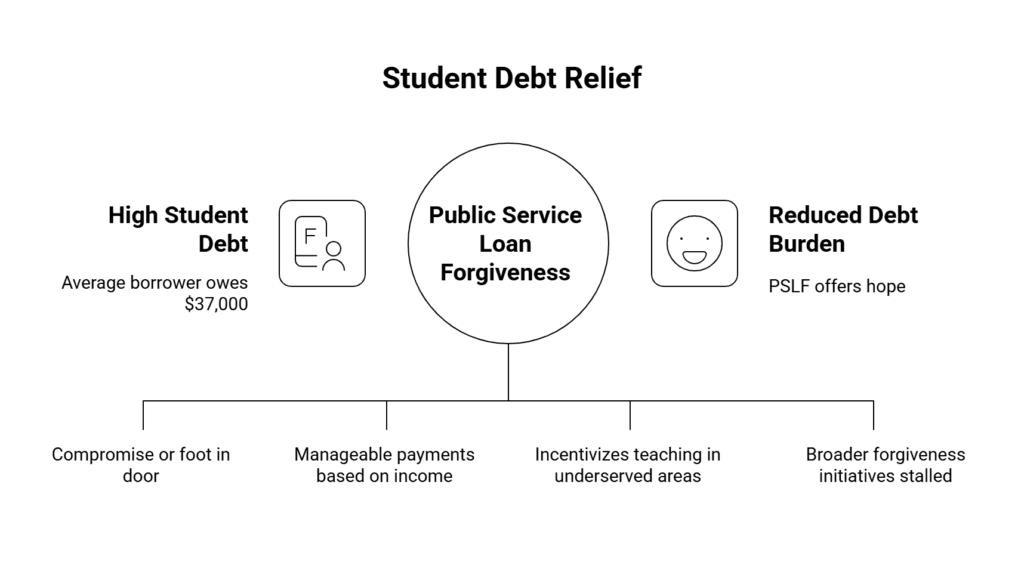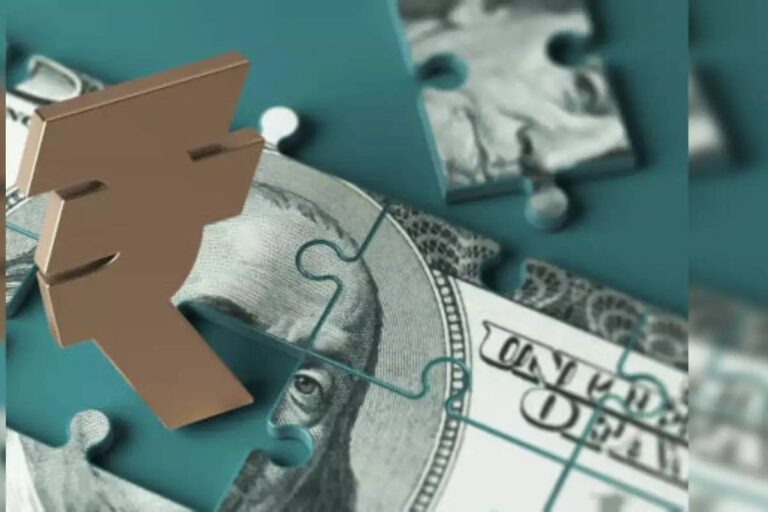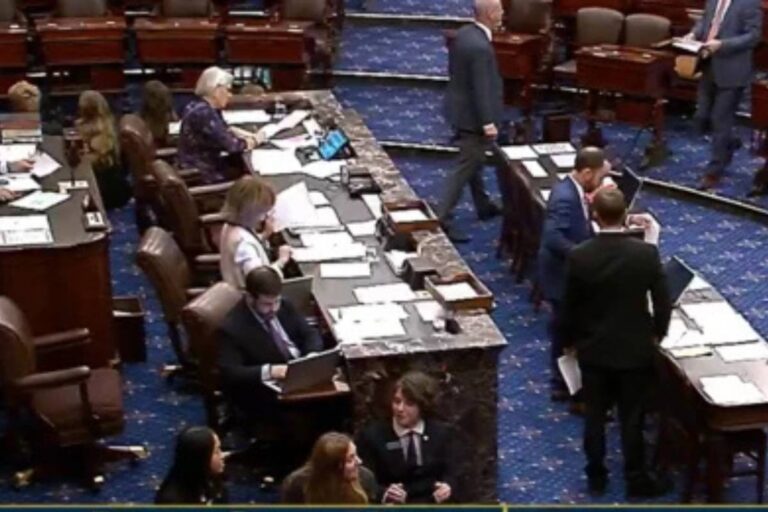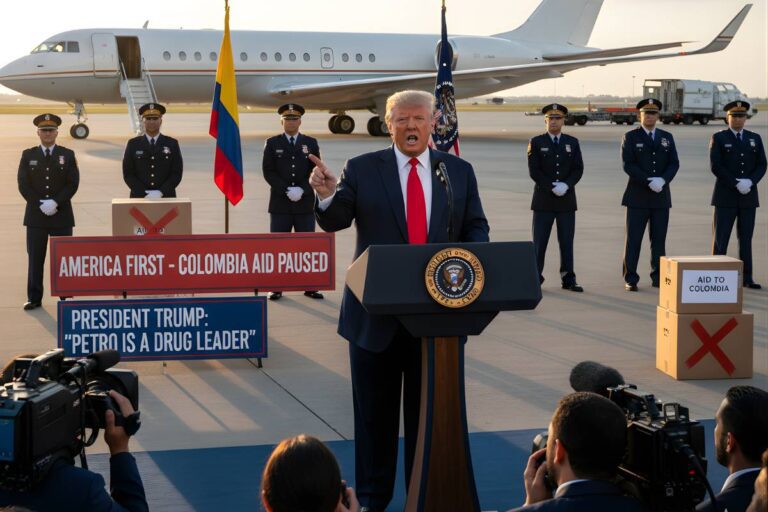Imagine dedicating a decade to helping others, teaching kids, caring for the sick, or supporting communities, only to find your promised debt relief yanked away. That’s the reality facing thousands under a new rule floated by the U.S. Department of Education. Here’s the deal: this proposal, pushed forward by the Trump administration, aims to tweak the Public Service Loan Forgiveness (PSLF) program in ways that could exclude entire organizations from eligibility.
Public workers like teachers, nurses, and social workers might suddenly lose out on forgiving their federal student loans. It’s stirring up quite the debate, you know, especially with student debt being such a hot-button issue these days. Let’s break it down step by step, starting with the basics.
Understanding the Public Service Loan Forgiveness Program
First off, what even is PSLF? Established back in 2007 under the College Cost Reduction and Access Act yeah, during the George W. Bush era, this program was designed to lure graduates into essential but often underpaid jobs. Think government roles or nonprofits. The pitch? Work full-time in public service for 10 years, make 120 qualifying monthly payments on your federal Direct Loans, and poof: the remaining balance gets forgiven, tax-free.
It’s not just a handout. The idea was to address the massive student debt crisis, over $1.7 trillion nationwide, last I checked, by encouraging folks to take on vital roles. Teachers shaping young minds, firefighters saving lives, nurses in understaffed hospitals… You get the picture. Without PSLF, many might skip these careers for higher-paying gigs in the private sector.
Over the years, it’s helped more than a million borrowers wipe out their debts. But it’s had its hiccups. Early on, under previous administrations, the approval rate was dismal, something like 1% of applications got through due to bureaucratic snags. Wrong loan types, missed payments, you name it. Then, reforms kicked in, especially during the Biden years, fixing those “past administrative failures” and boosting forgiveness numbers dramatically.
Funny thing is, even with those fixes, the program isn’t perfect. Borrowers have to jump through hoops: consolidate loans, pick the right repayment plan (like income-driven ones), and certify employment annually. Miss a step? You’re back to square one. And now, this new proposal could add another layer of complexity or exclusion.
The Core of the New Proposal: What’s Changing?
So, onto the meat of it. The Trump administration dropped this bombshell on Friday, proposing rules that would bar PSLF eligibility for employees at organizations involved in what they call activities with a “substantial illegal purpose.” Sounds vague, right? But it’s targeted.
Under the plan, the Education Secretary gets the final word on disqualifying employers. No need for a full court conviction, just a “preponderance of evidence,” meaning it’s more likely than not that something shady went down. That’s a lower bar than, say, beyond a reasonable doubt in a criminal trial.
What counts as “illegal”? The proposal lists specifics:
- Providing gender-affirming care to minors in states where it’s banned. They even describe it harshly as “chemical castration” via puberty blockers or hormone therapy.
- Aiding illegal immigration or human trafficking.
- Supporting foreign terrorist organizations.
- Other broad categories, like illegal discrimination.
Believe it or not, this could hit schools, universities, healthcare providers, social services, and legal aid groups hardest. For instance, a nonprofit helping immigrants might get flagged if their work brushes against federal immigration laws. Or a clinic offering transgender youth support in a restrictive state? Out.
The department insists it’ll affect fewer than 10 employers a year, with no big drop in overall forgiveness. But critics aren’t buying it. They worry it’s a tool to target groups opposing the administration’s views on immigration or gender issues. And here’s the kicker: once an organization is banned, its employees’ past payments toward forgiveness? They don’t count anymore. They’d have to switch jobs to keep qualifying, and the ban lasts 10 years unless fixed with a corrective plan.
This all stems from a March executive order by President Trump. He argued PSLF was funneling taxpayer money to “activist organizations” threatening national security and American values. The order directed officials to reshape the program, excluding those with illegal purposes. After a rulemaking panel in June couldn’t agree, the department forged ahead with its draft.
Historical Context: How We Got Here
To really grasp this, let’s rewind. Student loan forgiveness isn’t new, but PSLF was a game-changer when it launched. Congress wanted to boost public service amid rising college costs; tuition skyrocketed over 200% since the ’80s, leaving grads buried in debt.
Initially, uptake was slow. By 2017, only a handful had been forgiven. Complaints piled up: confusing rules, poor communication from servicers. The Government Accountability Office slammed the program for inefficiencies. Then came reforms. The Biden administration’s “account adjustment” in 2024 let borrowers get credit for past periods like deferments or forbearances, pushing forgiveness over the million mark.
But power shifts bring changes. Trump’s first term saw efforts to cut education spending and limit forgiveness programs. This proposal feels like an extension of that, focusing on “restoring” PSLF by narrowing who qualifies. It’s part of a broader push against what some see as overreach in areas like transgender rights or sanctuary cities.
Take gender-affirming care, for example. Over 20 states have banned it for minors, citing concerns about long-term effects. Supporters argue it’s lifesaving, backed by medical groups like the American Academy of Pediatrics. The proposal sidesteps that debate, focusing instead on state laws. If a clinic provides it where it’s illegal? PSLF eligibility is gone.
Immigration’s another flashpoint. Nonprofits aiding undocumented folks, legal aid, and shelters could be deemed as “aiding illegal immigration.” Yet many operate within the law, offering humanitarian help. The gray area here is huge, leaving room for interpretation.
Potential Impacts on Public Workers
Who stands to lose? Thousands, potentially. Teachers in public schools teaching certain histories, say, about slavery or civil rights, might get caught if it’s twisted into “illegal discrimination.” Nurses at clinics serving transgender youth? Same boat.
Social workers, university staff, and even first responders in “sanctuary” jurisdictions could feel the pinch. Imagine a firefighter in a city that limits cooperation with federal immigration enforcement. If that’s seen as abetting illegal activity, their loan payments stop counting.
The department downplays it, saying impacts won’t be widespread. But experts like those from the Student Borrower Protection Center warn of “millions” at risk indirectly. It’s not just about numbers; it’s morale. Public service jobs are tough, low-paying, and high-stress. PSLF is a lifeline, drawing talent. Pull it, and recruitment suffers.
For borrowers already in the program, it’s disruptive. Say you’ve got 8 years in; your employer gets disqualified. Those years? Wasted unless you job-hop. And in a tight market, that’s no small feat.
Economically, it ripples out. Forgiven debt means more spending power, on homes, families, and communities. Less forgiveness? More defaults, strained budgets. Nonprofits, already strapped, might lose staff or cut services.
If I’m honest, the uneven distribution is telling. Rural areas, underserved communities rely on PSLF-eligible workers. Hit them, and gaps widen.
Reactions from Stakeholders and Critics
Responses have been swift and polarized. Advocates like Kristin McGuire from Young Invincibles called it a “political stunt” to punish borrowers, weaponizing the system against foes via vague “illegal” definitions.
Former President Biden, in a 2024 speech, highlighted his administration’s fixes: “We promised to make good, and over a million public servants got their due.” It’s a stark contrast to this restrictive shift.
On the flip side, supporters argue it’s about accountability. Ensuring taxpayer dollars don’t fund lawbreakers, as per Trump’s executive order. The Education Department notes it addressed some concerns, like not barring groups just for First Amendment-protected advocacy, say, speaking on transgender rights without providing care.
Nonprofit groups, like the Council of Nonprofits, urge employees to check eligibility now. They emphasize PSLF’s value: full-time nonprofit or government work, 120 payments, and forgiveness. Resources abound, from StudentAid.gov to advisors.
Experts like Jonathan Collins from Columbia University flag the “gray area” for subjective purges. Winston Berkman-Breen warns that it attacks civil society, giving broad authority to play politics with lives.
Even the rulemaking process drew fire. A panel of experts met but couldn’t consensus, letting the department dictate terms. Some amendments added protections, but skeptics say it’s lipstick on a pig.
The Road Ahead: What’s Next?
The proposal isn’t law yet. There’s a 30-day public comment period, your chance to weigh in. After that, finalization, with changes possibly hitting July 2026.
If it passes, monitoring will be key. The secretary’s decisions could face lawsuits, challenges on vagueness, overreach, or free speech grounds. Courts have struck down similar rules before.
For now, if you’re in public service, act. Use the PSLF Help Tool to certify employment. Consolidate loans if needed. Track payments meticulously.
Broader reforms might follow. Student debt relief remains divisive; some push for total cancellation, others for tighter controls. This proposal underscores that divide.
In the end, it’s about balance. Encouraging public service while ensuring integrity. But at what cost to those already serving?
Deeper Dive: The Broader Student Debt Landscape

Zoom out, and this fits into America’s student debt saga. Average borrower owes $37,000; totals top $1.7 trillion. PSLF is one piece; others include income-driven repayment, teacher forgiveness, or Biden’s stalled broader plans.
Trump’s approach contrasts: his first term proposed ending PSLF altogether in budgets, though Congress balked. This targeted tweak might be a compromise or a foot in the door.
Globally, other nations handle education differently. Free tuition in parts of Europe means less debt burden. Here, it’s a market-driven system, with forgiveness as a patch.
Psychologically, debt weighs heavily. Studies show it delays marriages, homeownership, and even mental health. For public workers, PSLF offers hope amid that.
Case Studies: Real People Affected
Though specifics are emerging, consider hypotheticals based on patterns. A teacher in Texas, where gender care bans exist, works at a school with inclusive policies. If flagged, her 9 years toward forgiveness? Nullified.
Or a social worker at an immigrant aid nonprofit. Legal services, but if deemed “aiding” illegal entry? Disqualified.
These aren’t abstracts. Borrowers stuck in limbo from past backlogs, tens of thousands, per reports, know the frustration. One told CNBC of waiting years, only for more hurdles.
Policy Alternatives and Suggestions
While neutral, it’s worth noting the alternatives floated. Some suggest expanding PSLF to more fields, simplifying apps. Others want stricter oversight without broad exclusions.
The department’s panel suggested tweaks: protecting speech, limiting retroactivity. But without consensus, it’s the administration’s call.
Economic Ramifications for Nonprofits and Governments
Nonprofits employ millions, many relying on PSLF to attract talent. A ban could spike turnover, raise hiring costs. Governments, too, and local agencies might struggle in contentious areas.
Taxpayers foot the bill either way: forgiveness costs, but so do understaffed services. It’s a trade-off.
Legal and Constitutional Considerations
Constitutionally, the proposal treads on free speech, association. If it punishes legal advocacy, lawsuits loom. Preponderance standard? It could be challenged as arbitrary.
Past cases, like those on immigration sanctions, offer precedents. Watch for ACLU or similar involvement.
Global Perspectives on Student Debt Forgiveness
Compared to Canada or Australia, income-based repayments, some forgiveness. Less controversy, perhaps because debt loads are lower.
In the U.S., it’s politicized; Democrats expand, Republicans restrict. This proposal exemplifies that.
Advice for Borrowers Navigating Uncertainty
If you’re affected, don’t panic. Document everything. Seek free advice from groups like The Institute of Student Loan Advisors.
Consider backup plans: other forgiveness paths, refinancing (though that kills federal perks).
Stay informed, follow Education Department updates.
Wrapping Up the Bigger Picture
This proposal, if enacted, reshapes PSLF’s promise. For public workers, it’s a reminder: policies shift with the winds. Yet the need remains; serving communities shouldn’t bankrupt you.
As comments roll in, the final version might soften. Or not. Either way, it’s a chapter in the ongoing student debt story, one affecting real lives every day.






















